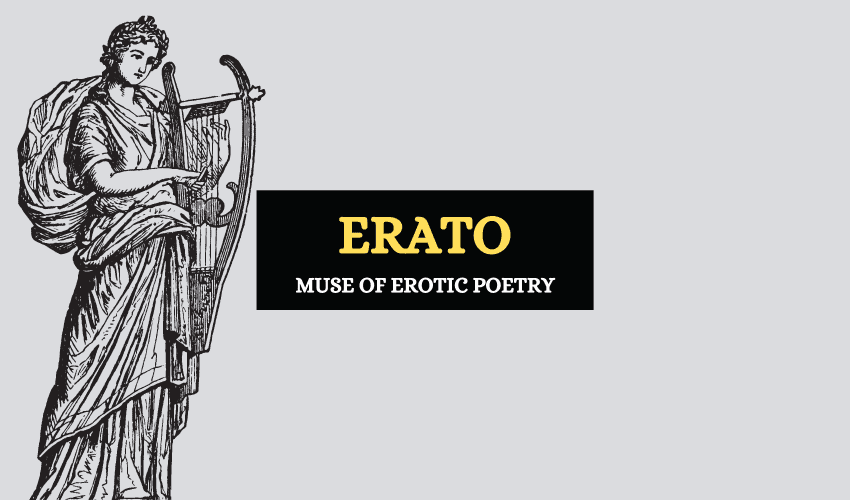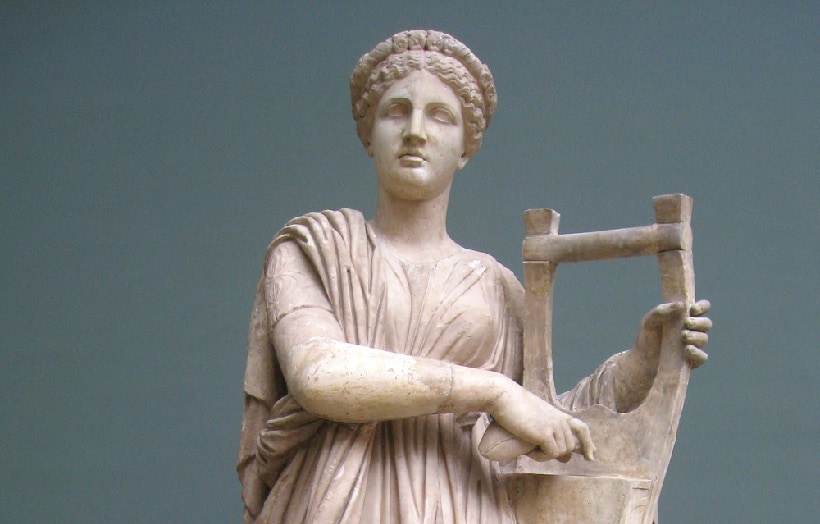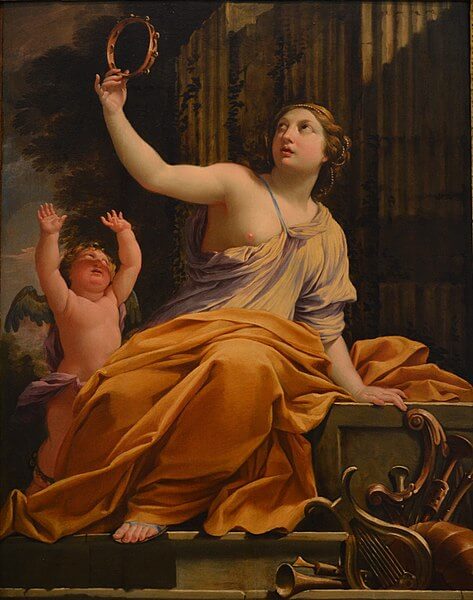
Table of Contents
Erato is regarded as one of the nine Greek Muses, the minor goddesses responsible for inspiring the Ancient Greeks to excel in the arts and sciences. Erato was the Muse of erotic poetry and mimic imitation. She also influenced songs about marriage. As a minor deity, she didn’t appear in any of her own myths.
However, she often appeared with her sisters in the myths of other well-known characters.

Who Was Erato?
According to the legend, Erato and her sisters came into being when Zeus, the king of the gods, and Mnemosyne, the Titan goddess of memory, laid together on nine consecutive nights. As a result, one of the nine Muses was conceived on each of these nights.
Erato and her sisters were as beautiful as their mother and each of them created the inspiration for an aspect of scientific and artist thought among the mortals. Erato’s domain was erotic poetry and mimic imitation and she was known to be quite the romantic.
Her sisters were Calliope (heroic poetry and eloquence), Urania (astronomy), Terpsichore (dance), Polyhymnia (sacred poetry), Euterpe (music), Clio (history), Thalia (comedy and festivity) and Melpomene (tragedy).
Although sources mention that the Muses were born the region of Piera, at the foot of Mount Olympus, they lived atop the mountain with the other Olympian gods and goddesses, including their father, Zeus.
Erato’s Appearance

Erato’s name means ‘lovely’ or ‘desired’ in Greek and this can be seen in how she’s usually depicted. She’s often shown as a young and very beautiful maiden, like her sisters, being seated with a wreath of roses and myrtle on her head.
It’s said that she was the most beautiful of of the nine Muses because of what she represented and her appearance alone inspired the creation and thoughts of love poetry.
In some representations, Erato is shown holding a golden arrow which is a symbol of ‘eros’ (love or desire), the feeling that she inspired in mortals. At times, she’s depicted holding a torch alongside the Greek god of love, Eros. She’s also often shown holding a lyre or a kithara, a musical instrument of Ancient Greece.
Erato is almost always depicted with her eight sisters and they were said to have been very close with each other. They spent most of their time together, singing, dancing and making merry.
Erato’s Offspring
According to the ancient sources, Erato had a daughter called Kleopheme or Kleophema by Malos, King of Malea, who was said to be her husband. Not much is known about Kleophema, except that she married Phlegyas, the son of the god of war, Ares.
Erato’s Role in Greek Mythology

As the goddess of erotic poetry, Erato represented all the writings that were associated with love, including songs about love and love poetry. She had a brilliant ability to influence the mortals to excel in the arts. It was the belief of the Ancient Greeks that they could achieve great things in the fields of art and science if they invoked the aid of Erato as well as her sisters, praying to her and making offerings.
Erato was very close with Eros, the god of love, better known as Cupid. She carried some golden arrows with her and would often accompany Eros as he wandered around making people fall in love. They would first inspire the mortals with love poems and feelings of love, then strike them with a golden arrow so that they’d fall in love with the first thing they’d see.
The Myth of Rhadine and Leontichus
Erato appeared in the famous myth of Leontichus and Rhadine, who were known as two star-crossed lovers from Samus, a town in Triphylia. Rhadine was a young girl who was supposed to marry a man from the ancient city of Corinth, but in the meantime, she had a secret love affair with Leontichus.
The man Rhadine was about to marry was a dangerous tyrant and when he found out about the affair, he was outraged and killed both his future wife and her lover. Their tomb, located in the city of Samos, was regarded as Erato’s tomb, and it later became a sacred place visited by lovers in the time of Pausanias.
Erato’s Associations and Symbols
In several renaissance paintings, she’s portrayed with a lyre or a kithara, a small instrument of the ancient Greeks. The kithara is often associated with Erato’s tutor, Apollo, who was also the god of music and dance. In the representations of Erato by Simon Vouet, two turtle-doves (symbols of love) can be seen at the feet of the goddess eating seeds.
Erato is mentioned in Hesiod’s Theogony with the other Muses and it’s said that the goddess was invoked at the beginning of the poem of Rhadine, which is now lost to the world.
Plato mentions Erato in his book Phaedrus and in Virgil’s Aenid. Virgil dedicated a part of the Iliadic section of the Aenid to the goddess of erotic poetry. He invoked her at the beginning of his seventh poem, requiring inspiration to write. Although this section of the poem is mostly focused on tragic and epic poetry, which were the domains of Erato’s sisters Melpomene and Calliope, Virgil still chose to invoke Erato.
In Brief
Today, not many people know about Erato and her role as the goddess of erotic poetry and mimic imitation. However, whenever the poets and writers of ancient Greece wanted to express love and passion, Erato was always believed to be present. Some who do know her say that the goddess is still around, ready to work her magic and inspire those who continue to invoke her aid.








